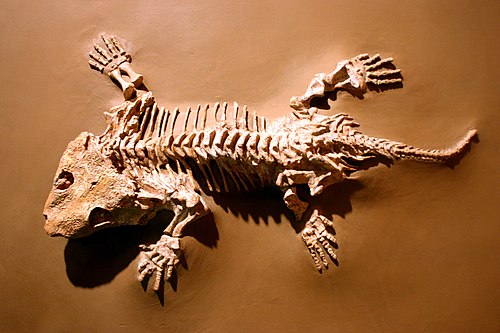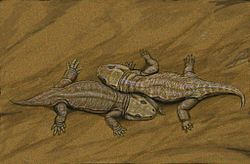Seymouria
Seymouria was an amphibian tetrapod from the early Permian of North America and Europe, about 280 to 270 million years ago (mya). It was small, only 2 ft (60 cm) long.
| Seymouria Temporal range: Early Permian
| |
|---|---|

| |
| A fossil of Seymouria baylorensis displayed at the National Museum of Natural History | |
| Scientific classification | |
| Unrecognized taxon (fix): | Seymouria |
| Species | |
| |
| Synonyms | |
| |
As an adult animal, Seymouria was well adapted to life on land, with many reptilian features. It was for quite a long time thought to be a primitive reptile. It is now known that its early life stages were in water. Apparently, it is an amphibian whose adult stage was adapted for life in a dry climate.
The discovery of its amphibian nature was a considerable surprise.
- "... the discovery of larval stages... demonstrated conclusively that the seymouriamorphs were not biologically amniotes".[1] Fossil larvae have been found of three related genera, from the Upper Carboniferous and Lower Permian of five European countries.[1]
- "It has been shown conclusively that seymouriamorphs had an amphibian-type life history, with aquatic young stages that lost their external gills after metamorphosis.... Seymouriamorphs were definitely not amniotes themselves".[2] This means they were not reptiles.
The adult skeletons were first found in the red beds of Texas and Oklahoma. These beds were laid down in the huge delta complex of a large river flowing towards a coast, much like the Mississippi of today.[1] The species found in Germany and New Mexico, Seymouria sanjuanensis, had massive legs and held its body well off the ground. This shows an "effective adaptation to terrestrial locomotion".[1]
A simplified life cycle might be: eggs laid in water, larval stages in water, young animal with limbs climbs out and instinctively moves to higher ground. All its life lived as a carnivore on dry land, returning to water occasionally to drink and to breed. The adults would be able to operate in a fairly dry climate.
Seymouria Media
A Seymouria model at the Milwaukee Public Museum
References
- ↑ 1.0 1.1 1.2 1.3 Carroll, Robert 2009. The rise of amphibians: 365 million years of evolution. The Johns Hopkins University Press, p163 (left-hand column).
- ↑ Clack, Jennifer 2012. Gaining ground: the origin and evolution of tetrapods. 2nd ed, Indiana University Press. Seymouriamorphs p353/6; quote: p356.






